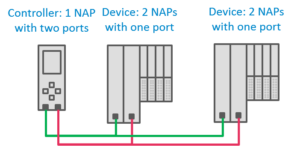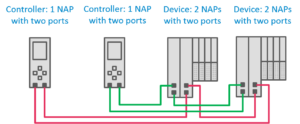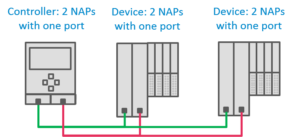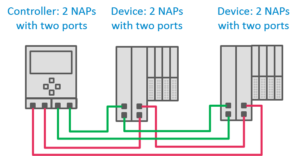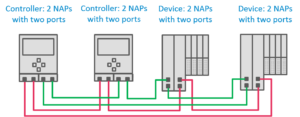PROFINET implements redundancy in multiple ways to tolerate multiple types of failures. A PROFINET system can be designed to tolerate a failure of a device, a controller, or even the media that connects them within a network. But there’s another component of a PROFINET system that can fail: the network itself.
Availability in the worst-case scenario
Network redundancy is a key part of the System Redundancy concept from the High Availability profile for PROFINET document. It allows PROFINET devices and controllers to not just share media redundancy within a single network, but to be connected to multiple networks via Network Access Points (NAPs). This is separate from Media redundancy. Each NAP may only have a single port, and MRP may not be possible.
So while a PROFINET device or controller with multiple NAPs implements network redundancy, it may also implement media redundancy within those networks. A NAP is a completely self-contained network interface: it has its own networking hardware, MAC addresses, IP address, DCP name, etc.
Because NAPs are independent from each other, they can be connected in a lot of ways to meet the needs of controller, device, network and media redundancy. Each configuration can be used to achieve some level of availability that are described as S1, S2, R1 and R2 connections.
Common combinations of Network, Media, Device and Controller Redundancy
Balancing Redundancy with Complexity
Network Redundancy fits in to the high availability concept at the highest levels of complexity. Multiple NAPs enable some of the most resilient (R2) system architectures. But that resiliency comes at the cost of complexity in device design and system implementation. Only a few mission-critical systems require Network Redundancy, and only a few PROFINET devices and controllers support it. So, if you’re interested in implementing Network Redundancy in your PROFINET system, discuss it with your application engineers and PROFINET vendors.
 Continue your education by completing a PROFINET Certified Network Engineer Course.
Continue your education by completing a PROFINET Certified Network Engineer Course.
These certification classes are intense, hands-on courses. You will learn how the underlying technology works from the application to the frame level. After passing both a practical and written exam, you become certified.
For more information, contact us or visit our website.
